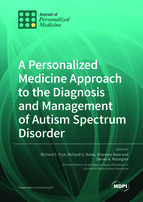A Personalized Medicine Approach to the Diagnosis and Management of Autism Spectrum Disorder
A special issue of Journal of Personalized Medicine (ISSN 2075-4426). This special issue belongs to the section "Mechanisms of Diseases".
Deadline for manuscript submissions: closed (5 June 2021) | Viewed by 144473
Special Issue Editors
2. Southwest Autism Research and Resource Center, Phoenix, AZ 85006, USA
3. Autism Discovery and Treatment Foundation, Phoenix, AZ 85050, USA
Interests: neurodevelopment disorders; metabolic disorders; autism; mitochondrial disorders; folate metabolism; redox metabolism
Special Issues, Collections and Topics in MDPI journals
Interests: mitochondrial medicine; functional disease (including cyclic vomiting syndrome, other atypical forms of migraine, and chronic fatigue syndrome); autism spectrum disorders
Special Issues, Collections and Topics in MDPI journals
Interests: oxidative stress; mitochondrial abnormalities; autism spectrum disorders (ASD)
Special Issues, Collections and Topics in MDPI journals
Interests: autism spectrum disorders; cerebral palsy; neurological and developmental disorders; PANS/PANDAS; ADD/ADHD; pediatric special needs
Special Issues, Collections and Topics in MDPI journals
Special Issue Information
Dear Colleagues,
Background: Autism spectrum disorder (ASD) presents with a spectrum of symptoms and is believed to be caused by a variety of etiologies. Additionally, response to treatment for individuals with ASD is very variable and unpredictable. Furthermore, the diagnosis of ASD is based on behavioral observation rather than an objective metric.
Aim and scope: We aim to publish articles describing a personalized medicine approach to the diagnosis, classification, and treatment of ASD.
History: ASD is a difficult disorder to diagnosis and treat, both because its diagnosis is traditionally not based on objective biomarkers and because there are many underlying causes which are difficult to identify. This results in each individuals with ASD having a unique presentation. Thus, a personalized medicine approach could greatly benefit this population.
Cutting-edge research: Quantitative behavioral measurements as well as genetic, epigenetic, physiologic, metabolic, and proteomic biomarkers have been investigated for use in the management of ASD.
What kind of papers we are soliciting: We encourage the submission of manuscripts which describe a personalized medicine approach to the diagnosis, classification, and treatment approach to ASD.
Prof. Richard E. Frye
Guest Editor
Manuscript Submission Information
Manuscripts should be submitted online at www.mdpi.com by registering and logging in to this website. Once you are registered, click here to go to the submission form. Manuscripts can be submitted until the deadline. All submissions that pass pre-check are peer-reviewed. Accepted papers will be published continuously in the journal (as soon as accepted) and will be listed together on the special issue website. Research articles, review articles as well as short communications are invited. For planned papers, a title and short abstract (about 100 words) can be sent to the Editorial Office for announcement on this website.
Submitted manuscripts should not have been published previously, nor be under consideration for publication elsewhere (except conference proceedings papers). All manuscripts are thoroughly refereed through a single-blind peer-review process. A guide for authors and other relevant information for submission of manuscripts is available on the Instructions for Authors page. Journal of Personalized Medicine is an international peer-reviewed open access monthly journal published by MDPI.
Please visit the Instructions for Authors page before submitting a manuscript. The Article Processing Charge (APC) for publication in this open access journal is 2600 CHF (Swiss Francs). Submitted papers should be well formatted and use good English. Authors may use MDPI's English editing service prior to publication or during author revisions.
Keywords
- Autism Spectrum Disorder
- Quantitative Behavior
- Neurophysiology
- Genetic
- Epigenetic
- Metabolomics
- Mitochondria
- Redox Metabolism
- Methylation
- Autonomic Dysfunction
- Folate Metabolism










